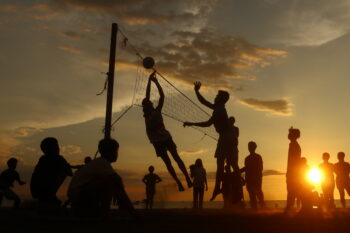ALEOSAN, North Cotabato (MindaNews/13 August) — Pagangan, with its rolling hills and plains, is the last barangay of the Aleosan municipality, on the boundary that separates it from the town of Pikit in North Cotabato. Covering 1,067 hectares, it became a barangay in 1937 when it was yet a Manobo settlement. Later on, Ilongo, Maguindanaon, and Cebuano settlers came to make the village their home. The area became heavily contested, especially during the active secessionist moves in the 1970’s of the Moro National Liberation Front (MNLF) Blackshirts and the paramilitary community defense put up by self-fashioned Ilaga. Many residents fled the area to avoid being caught in the crossfire.
Uneasy peace came to Pagangan in 1976 when MNLF leader Hadji Salik Nawal surrendered to the government. Portions of the hilly barangay, however, remain to be an active transit area for armed secessionist groups, especially with the ideological split between the MNLF and the MILF in 1984 (Rodell, 2007). Pagangan was affected by the breakdown in on again-off again peace talks between the Philippine government and the MILF in 2000, 2004, and 2008.
Identified as a resident community of former MNLF combatants, Pagangan was among the recipients of the multidonor development package under the terms of the 1996 Final Peace Agreement (FPA) between the Philippine government and the MNLF. The delivered projects include a barangay health station, a cattle dispersal project, and infrastructure for postharvest facilities. The peace and order situation, however, remains of concern, as the incursion by rogue MILF elements, especially in the region called the Tubac complex, required the mounting of heavy military operations several times in the years after the 1996 FPA, the most recent having been in August 2008.
As of 2007, there were 607 households in the barangay, earning an average of PhP3,066 per month, mostly from farming endeavors. Agricultural development assistance is split, with government support pushing for the use of synthetic fertilizers while NGOs promote the use of organic farm inputs. Microfinance access, however, remains limited.
An active community leader, talks about conditions in Pagangan and its environs:
Aleosan in North Cotabato is productive… very productive in terms of rice and corn, and we also grow high value crops here. Among ourselves we are peaceful, but when a third party comes in, like the MILF that conducts incursion into our place, it turns bad for us. It’s like our situation goes into a rapid decline every time we need to evacuate. And then recently, we also experienced flooding because some portions of the hills were turned into swidden farms. The people in the uplands have no other source of livelihood but to convert the hills into swidden farms. The local government hasn’t responded with appropriate interventions, so they’re still doing it up there. Those of us in the lowlands suffer; the flood when it came even carried away the bridge.
Yes, the people would know when fighting was about to happen. We would know because (rogue MILF commander) Ombra Kato, for example, would send emissaries to let us know of their presence. And then there were intelligence reports. It seems like every three years, fighting comes to our community – 2000, 2004, 2008 – combatants battled it out in our community. We would start counting, because we would be given housing after the fighting. Our homes would be damaged. Sometimes we joke among ourselves that our houses look old already, it’s about time for war again so we would again be given new houses.
On the third year after the last one, we come to expect that war would happen again. Based on my experience, we plant coconuts and bananas hoping that after five years it would sustain the children’s needs for school… But when wars come, our farms get burned down to the ground because this is where the MILF troops would hide, so the military would have to flush them out. We have to start all over again. We plant again. Then, after three years… That’s how it is.
Among us tripeoples in Aleosan, we come to each other’s aid. When a Muslim gets married, the Christians help out. If it’s a Christian wedding, the Muslims and the Manobos would be there to take part in the preparations and in the celebration, too. We are a tripeople community – we feel for each other in times when the (peace) negotiations are ongoing. It is only when the peace talks break down, when the negotiators disagree at the table and contending demands are not acceptable, that we experience strife. What can we do? When the military comes in with their 105 (mm Howitzers), violence and conflagration are sure to beset our village anew. Without the big guns, there won’t be any of that, I think. But what can we do?
Yes, we have been helped. Because of what happened to us, there have been interventions by foreign donors, the provincial government, the local municipal government, and the NGOs. The biggest assistance was provided by the ACT for Peace Programme in its attempt to aid us with a total rehabilitation package.
In years past, when violence came to Aleosan, we scattered. We went our separate ways. But in recent years, we have become more aware of the need to stay together. We have assigned persons and committees that people can go to in cases of emergency. Then, we also have disaster awareness, and an awareness of the applicable laws. We have identified relays in the distribution of relief – whereas before, there was only one person who accepted for the community. Like, a one-man rule. There was a problem then with relief not getting to some people. But now, we are more aware and are guided by the law.
Here’s an anecdote about war in the area. Pagangan sits right next to Nalapaan in Pikit. Fighting does not get to Nalapaan because it is part of what we call the G7 – the Spaces for Peace that former Pikit parish priest Fr. Bert Layson worked to establish. After the war in 2004, on November 29, 2004, an accord was signed here with (former Defense Secretary) Angelo Reyes and (former MILF chairperson) Hashim Salamat that Nalapaan will be spared from war. Combatants should not come in to fight. Ombra Kato should not come in. Even he recognizes the accord.
Nalapaan is in Pikit, and Pagangan is in Aleosan. They’re the boundary barangays that separate the two towns. Pangangan is not part of the G7, however. So when Pagangan got bombed by helicopter gunships, some of the bombs fell on the farms and houses in Nalapaan. And for the tanks to get to Pangangan, they had to pass through Nalapaan. But no firing. When that happens, of course, Nalapaan residents are terrified to get hit in the crossfire, they would still have to evacuate. But we’re not so scared any more because we now have disaster awareness. It could get very turbulent, though. That’s the picture of war in North Cotabato.
(Wayward and Fanciful is Gail Ilagan’s column for MindaViews, the opinion section of MindaNews. Ilagan teaches Social Justice, Family Sociology, Theories of Socialization and Psychology at the Ateneo de Davao University where she is also the associate editor of Tambara. You may send comments to gail@mindanews.com. “Send at the risk of a reply,” she says.)







